Math Assignment
VerifiedAdded on 2023/04/08
|5
|1097
|285
AI Summary
This math assignment covers topics such as exponential growth, inverse functions, derivatives, and population modeling. It also includes calculations for book scores and popularity tracking in an election campaign.
Contribute Materials
Your contribution can guide someone’s learning journey. Share your
documents today.
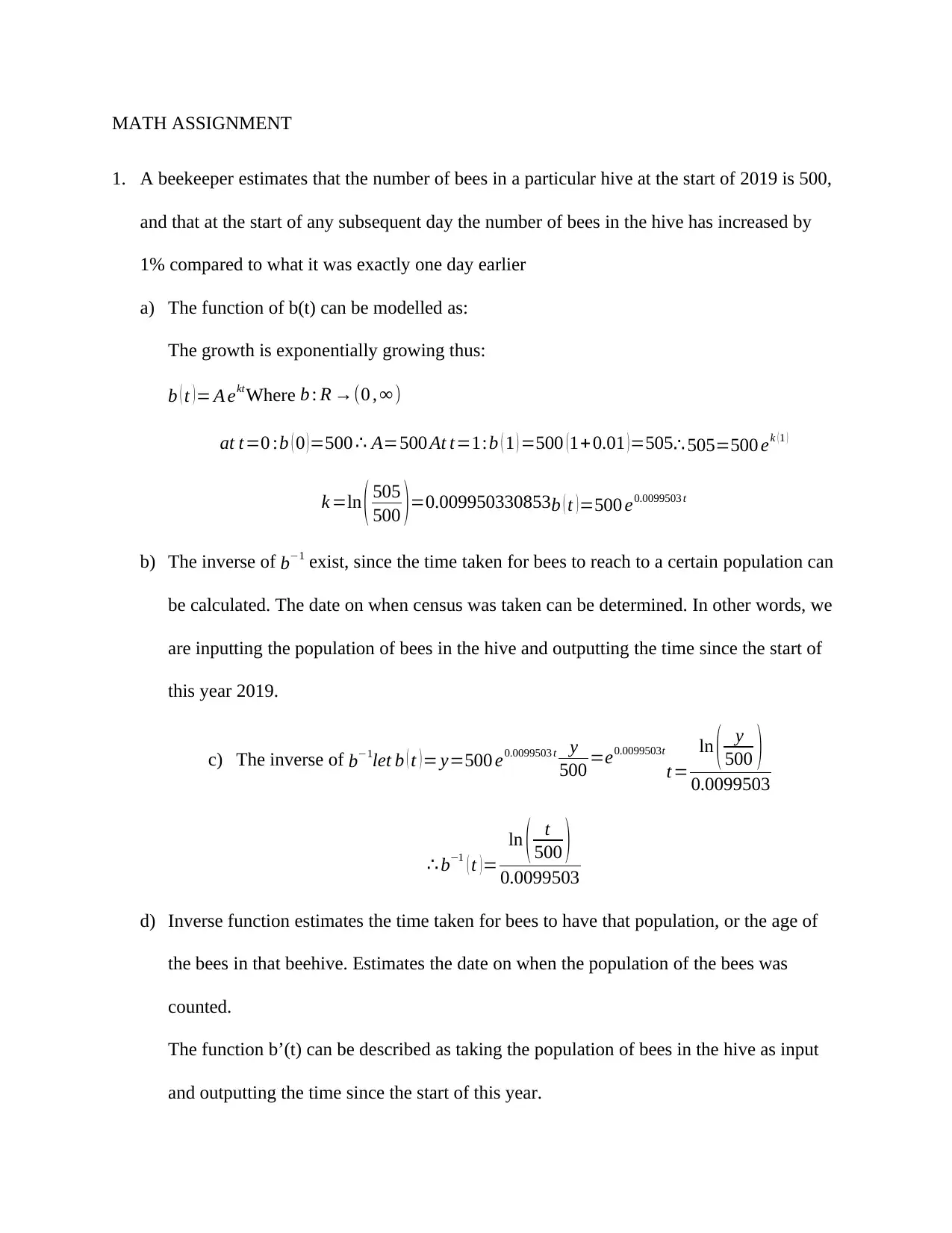
MATH ASSIGNMENT
1. A beekeeper estimates that the number of bees in a particular hive at the start of 2019 is 500,
and that at the start of any subsequent day the number of bees in the hive has increased by
1% compared to what it was exactly one day earlier
a) The function of b(t) can be modelled as:
The growth is exponentially growing thus:
b ( t )= A ektWhere b : R →(0 , ∞ )
at t=0 :b ( 0 )=500 ∴ A=500 At t=1:b ( 1 ) =500 ( 1+ 0.01 ) =505∴ 505=500 ek (1 )
k =ln ( 505
500 )=0.009950330853b ( t )=500 e0.0099503 t
b) The inverse of b−1 exist, since the time taken for bees to reach to a certain population can
be calculated. The date on when census was taken can be determined. In other words, we
are inputting the population of bees in the hive and outputting the time since the start of
this year 2019.
c) The inverse of b−1let b ( t )= y=500 e0.0099503 t y
500 =e0.0099503t
t=
ln ( y
500 )
0.0099503
∴ b−1 ( t ) =
ln ( t
500 )
0.0099503
d) Inverse function estimates the time taken for bees to have that population, or the age of
the bees in that beehive. Estimates the date on when the population of the bees was
counted.
The function b’(t) can be described as taking the population of bees in the hive as input
and outputting the time since the start of this year.
1. A beekeeper estimates that the number of bees in a particular hive at the start of 2019 is 500,
and that at the start of any subsequent day the number of bees in the hive has increased by
1% compared to what it was exactly one day earlier
a) The function of b(t) can be modelled as:
The growth is exponentially growing thus:
b ( t )= A ektWhere b : R →(0 , ∞ )
at t=0 :b ( 0 )=500 ∴ A=500 At t=1:b ( 1 ) =500 ( 1+ 0.01 ) =505∴ 505=500 ek (1 )
k =ln ( 505
500 )=0.009950330853b ( t )=500 e0.0099503 t
b) The inverse of b−1 exist, since the time taken for bees to reach to a certain population can
be calculated. The date on when census was taken can be determined. In other words, we
are inputting the population of bees in the hive and outputting the time since the start of
this year 2019.
c) The inverse of b−1let b ( t )= y=500 e0.0099503 t y
500 =e0.0099503t
t=
ln ( y
500 )
0.0099503
∴ b−1 ( t ) =
ln ( t
500 )
0.0099503
d) Inverse function estimates the time taken for bees to have that population, or the age of
the bees in that beehive. Estimates the date on when the population of the bees was
counted.
The function b’(t) can be described as taking the population of bees in the hive as input
and outputting the time since the start of this year.
Secure Best Marks with AI Grader
Need help grading? Try our AI Grader for instant feedback on your assignments.
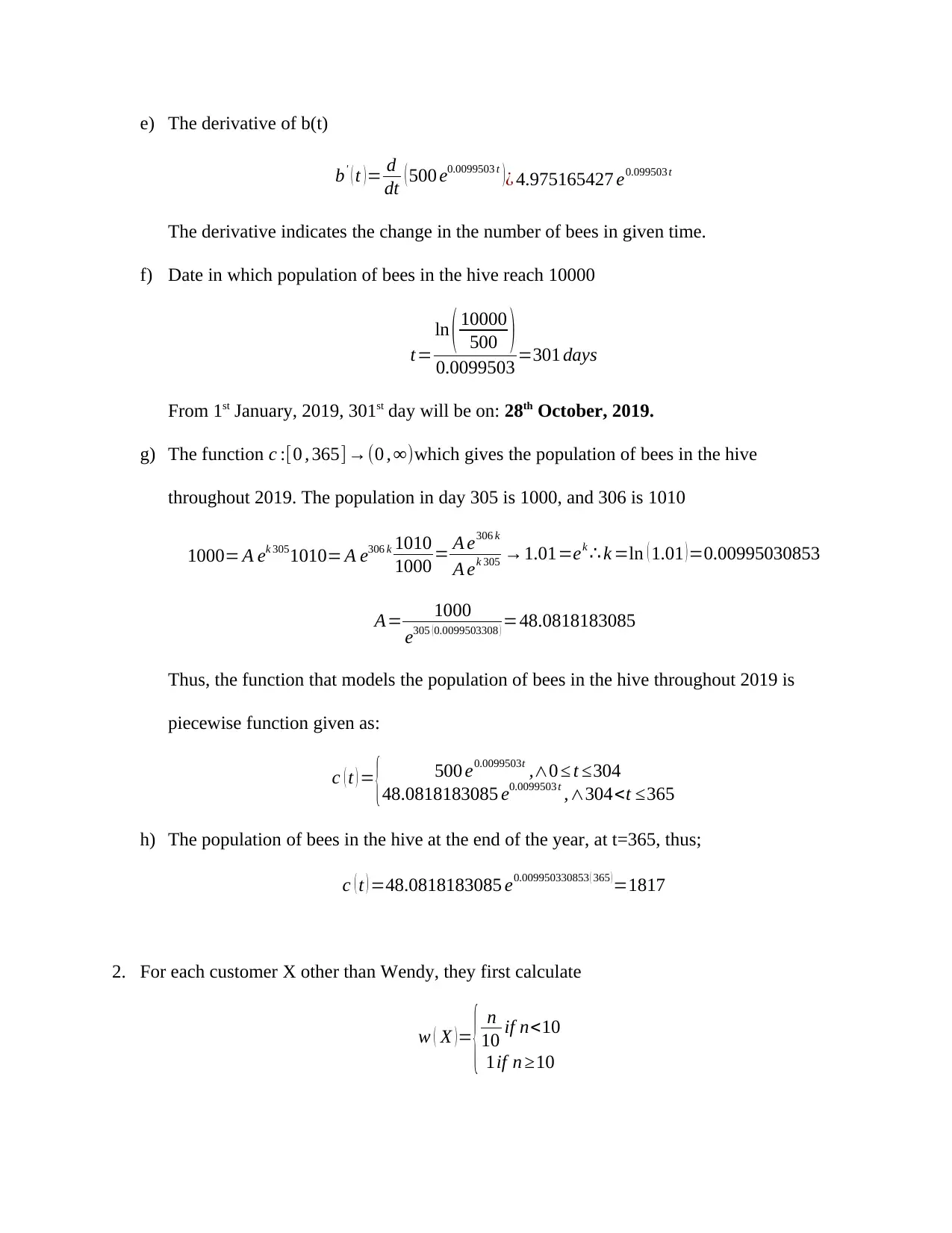
e) The derivative of b(t)
b' ( t )= d
dt ( 500 e0.0099503 t )¿ 4.975165427 e0.099503 t
The derivative indicates the change in the number of bees in given time.
f) Date in which population of bees in the hive reach 10000
t=
ln ( 10000
500 )
0.0099503 =301 days
From 1st January, 2019, 301st day will be on: 28th October, 2019.
g) The function c :[0 , 365]→(0 , ∞)which gives the population of bees in the hive
throughout 2019. The population in day 305 is 1000, and 306 is 1010
1000= A ek 305 1010= A e306 k 1010
1000 = A e306 k
A ek 305 →1.01=ek ∴ k =ln ( 1.01 )=0.00995030853
A= 1000
e305 ( 0.0099503308 ) =48.0818183085
Thus, the function that models the population of bees in the hive throughout 2019 is
piecewise function given as:
c ( t ) = { 500 e0.0099503t ,∧0 ≤ t ≤304
48.0818183085 e0.0099503 t ,∧304<t ≤365
h) The population of bees in the hive at the end of the year, at t=365, thus;
c ( t ) =48.0818183085 e0.009950330853 ( 365 )=1817
2. For each customer X other than Wendy, they first calculate
w ( X )= { n
10 if n<10
1if n ≥10
b' ( t )= d
dt ( 500 e0.0099503 t )¿ 4.975165427 e0.099503 t
The derivative indicates the change in the number of bees in given time.
f) Date in which population of bees in the hive reach 10000
t=
ln ( 10000
500 )
0.0099503 =301 days
From 1st January, 2019, 301st day will be on: 28th October, 2019.
g) The function c :[0 , 365]→(0 , ∞)which gives the population of bees in the hive
throughout 2019. The population in day 305 is 1000, and 306 is 1010
1000= A ek 305 1010= A e306 k 1010
1000 = A e306 k
A ek 305 →1.01=ek ∴ k =ln ( 1.01 )=0.00995030853
A= 1000
e305 ( 0.0099503308 ) =48.0818183085
Thus, the function that models the population of bees in the hive throughout 2019 is
piecewise function given as:
c ( t ) = { 500 e0.0099503t ,∧0 ≤ t ≤304
48.0818183085 e0.0099503 t ,∧304<t ≤365
h) The population of bees in the hive at the end of the year, at t=365, thus;
c ( t ) =48.0818183085 e0.009950330853 ( 365 )=1817
2. For each customer X other than Wendy, they first calculate
w ( X )= { n
10 if n<10
1if n ≥10
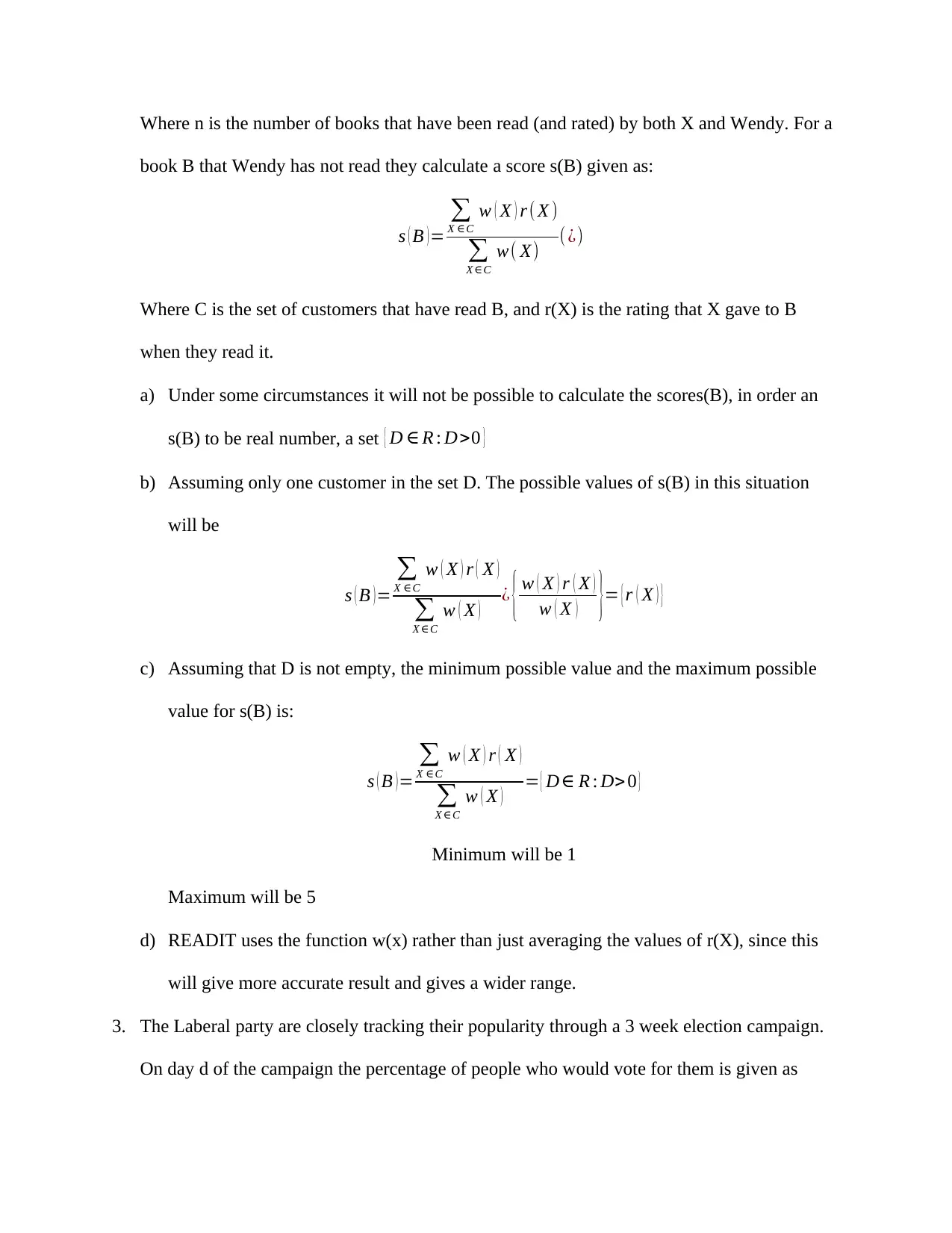
Where n is the number of books that have been read (and rated) by both X and Wendy. For a
book B that Wendy has not read they calculate a score s(B) given as:
s ( B ) =
∑
X ∈C
w ( X ) r ( X )
∑
X ∈C
w( X) ( ¿)
Where C is the set of customers that have read B, and r(X) is the rating that X gave to B
when they read it.
a) Under some circumstances it will not be possible to calculate the scores(B), in order an
s(B) to be real number, a set { D ∈ R : D>0 }
b) Assuming only one customer in the set D. The possible values of s(B) in this situation
will be
s ( B )=
∑
X ∈C
w ( X ) r ( X )
∑
X ∈C
w ( X ) ¿ { w ( X ) r ( X )
w ( X ) }= { r ( X ) }
c) Assuming that D is not empty, the minimum possible value and the maximum possible
value for s(B) is:
s ( B )=
∑
X ∈C
w ( X ) r ( X )
∑
X ∈C
w ( X ) = { D∈ R : D> 0 }
Minimum will be 1
Maximum will be 5
d) READIT uses the function w(x) rather than just averaging the values of r(X), since this
will give more accurate result and gives a wider range.
3. The Laberal party are closely tracking their popularity through a 3 week election campaign.
On day d of the campaign the percentage of people who would vote for them is given as
book B that Wendy has not read they calculate a score s(B) given as:
s ( B ) =
∑
X ∈C
w ( X ) r ( X )
∑
X ∈C
w( X) ( ¿)
Where C is the set of customers that have read B, and r(X) is the rating that X gave to B
when they read it.
a) Under some circumstances it will not be possible to calculate the scores(B), in order an
s(B) to be real number, a set { D ∈ R : D>0 }
b) Assuming only one customer in the set D. The possible values of s(B) in this situation
will be
s ( B )=
∑
X ∈C
w ( X ) r ( X )
∑
X ∈C
w ( X ) ¿ { w ( X ) r ( X )
w ( X ) }= { r ( X ) }
c) Assuming that D is not empty, the minimum possible value and the maximum possible
value for s(B) is:
s ( B )=
∑
X ∈C
w ( X ) r ( X )
∑
X ∈C
w ( X ) = { D∈ R : D> 0 }
Minimum will be 1
Maximum will be 5
d) READIT uses the function w(x) rather than just averaging the values of r(X), since this
will give more accurate result and gives a wider range.
3. The Laberal party are closely tracking their popularity through a 3 week election campaign.
On day d of the campaign the percentage of people who would vote for them is given as
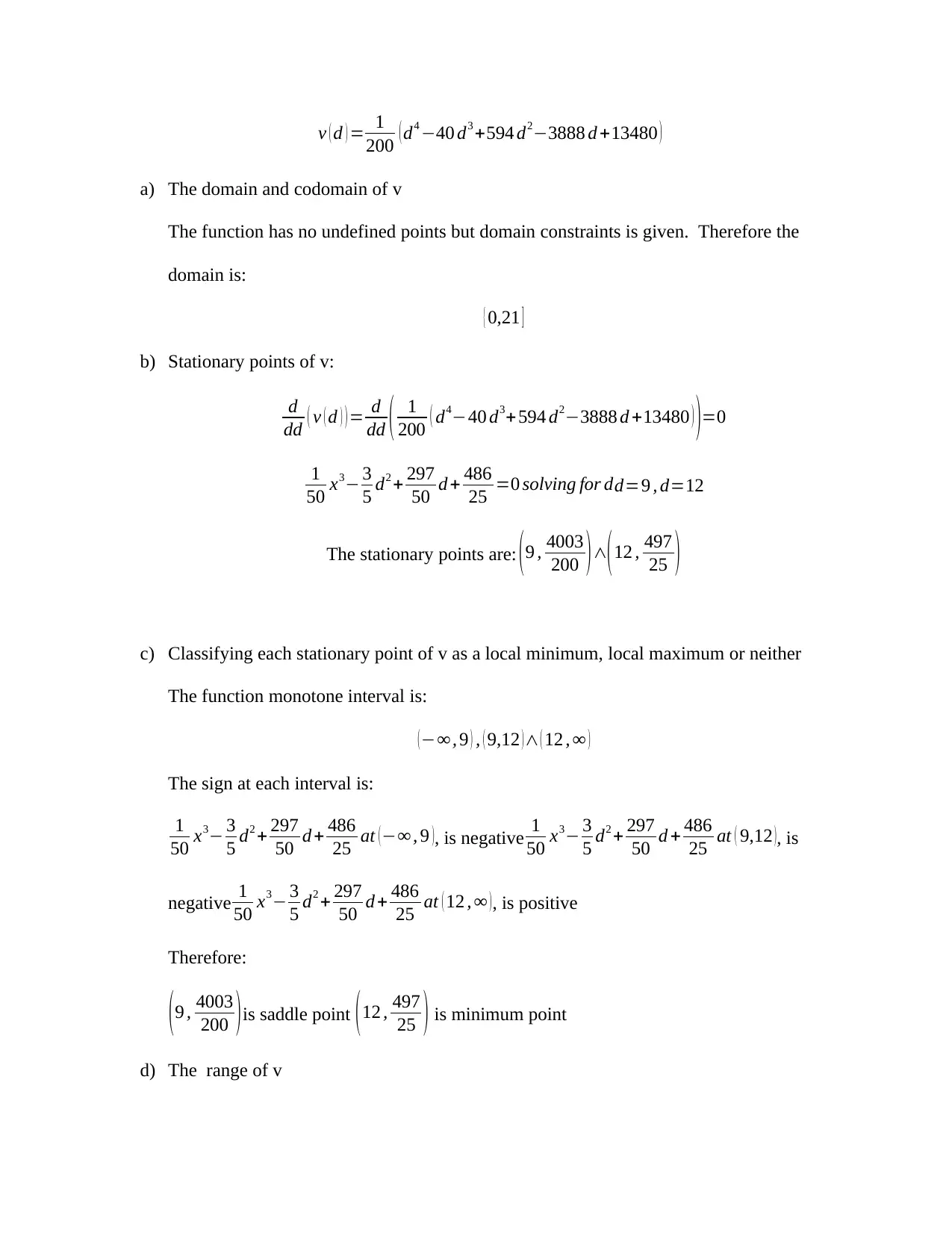
v ( d ) = 1
200 ( d4 −40 d3 +594 d2−3888 d +13480 )
a) The domain and codomain of v
The function has no undefined points but domain constraints is given. Therefore the
domain is:
{ 0,21 ]
b) Stationary points of v:
d
dd ( v ( d ) ) = d
dd ( 1
200 ( d4−40 d3+594 d2−3888 d +13480 ) )=0
1
50 x3− 3
5 d2 + 297
50 d + 486
25 =0 solving for d d=9 , d=12
The stationary points are: ( 9 , 4003
200 ) ∧( 12 , 497
25 )
c) Classifying each stationary point of v as a local minimum, local maximum or neither
The function monotone interval is:
(−∞, 9 ) , ( 9,12 )∧ ( 12 , ∞ )
The sign at each interval is:
1
50 x3− 3
5 d2 + 297
50 d + 486
25 at (−∞ , 9 ), is negative 1
50 x3− 3
5 d2 + 297
50 d + 486
25 at ( 9,12 ), is
negative 1
50 x3− 3
5 d2 + 297
50 d + 486
25 at ( 12 , ∞ ), is positive
Therefore:
(9 , 4003
200 )is saddle point (12 , 497
25 ) is minimum point
d) The range of v
200 ( d4 −40 d3 +594 d2−3888 d +13480 )
a) The domain and codomain of v
The function has no undefined points but domain constraints is given. Therefore the
domain is:
{ 0,21 ]
b) Stationary points of v:
d
dd ( v ( d ) ) = d
dd ( 1
200 ( d4−40 d3+594 d2−3888 d +13480 ) )=0
1
50 x3− 3
5 d2 + 297
50 d + 486
25 =0 solving for d d=9 , d=12
The stationary points are: ( 9 , 4003
200 ) ∧( 12 , 497
25 )
c) Classifying each stationary point of v as a local minimum, local maximum or neither
The function monotone interval is:
(−∞, 9 ) , ( 9,12 )∧ ( 12 , ∞ )
The sign at each interval is:
1
50 x3− 3
5 d2 + 297
50 d + 486
25 at (−∞ , 9 ), is negative 1
50 x3− 3
5 d2 + 297
50 d + 486
25 at ( 9,12 ), is
negative 1
50 x3− 3
5 d2 + 297
50 d + 486
25 at ( 12 , ∞ ), is positive
Therefore:
(9 , 4003
200 )is saddle point (12 , 497
25 ) is minimum point
d) The range of v
Secure Best Marks with AI Grader
Need help grading? Try our AI Grader for instant feedback on your assignments.
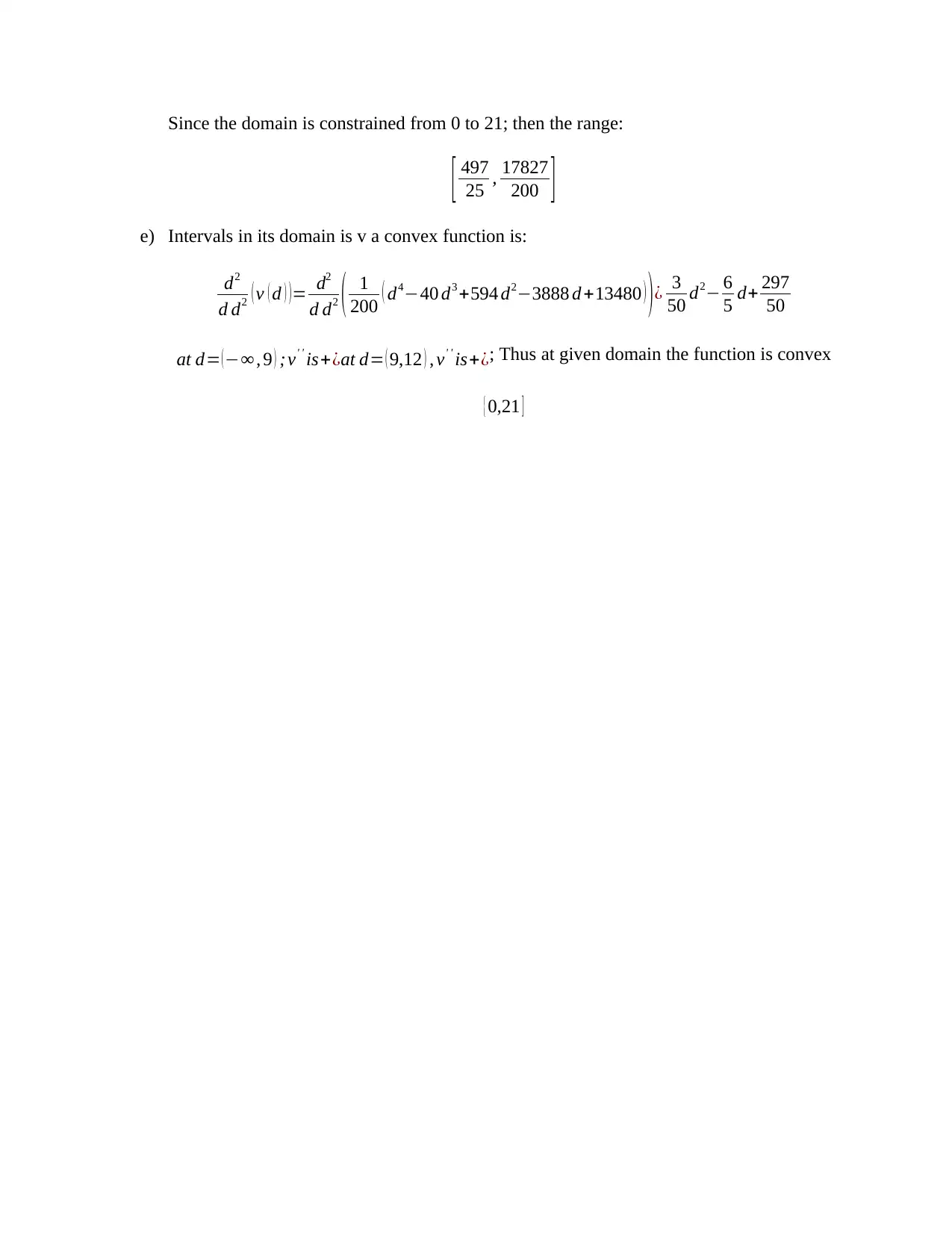
Since the domain is constrained from 0 to 21; then the range:
[ 497
25 , 17827
200 ]
e) Intervals in its domain is v a convex function is:
d2
d d2 ( v ( d ) )= d2
d d2 ( 1
200 ( d4−40 d3 +594 d2−3888 d +13480 ) )¿ 3
50 d2− 6
5 d+ 297
50
at d= ( −∞ , 9 ) ;v' ' is+¿at d= ( 9,12 ) , v' ' is+¿; Thus at given domain the function is convex
{ 0,21 ]
[ 497
25 , 17827
200 ]
e) Intervals in its domain is v a convex function is:
d2
d d2 ( v ( d ) )= d2
d d2 ( 1
200 ( d4−40 d3 +594 d2−3888 d +13480 ) )¿ 3
50 d2− 6
5 d+ 297
50
at d= ( −∞ , 9 ) ;v' ' is+¿at d= ( 9,12 ) , v' ' is+¿; Thus at given domain the function is convex
{ 0,21 ]
1 out of 5
Your All-in-One AI-Powered Toolkit for Academic Success.
+13062052269
info@desklib.com
Available 24*7 on WhatsApp / Email
![[object Object]](/_next/static/media/star-bottom.7253800d.svg)
Unlock your academic potential
© 2024 | Zucol Services PVT LTD | All rights reserved.
